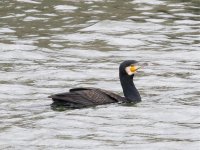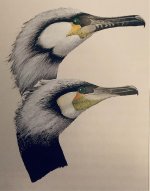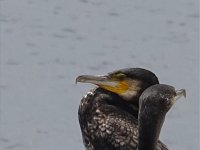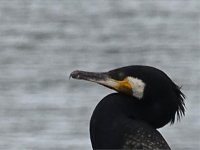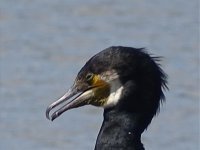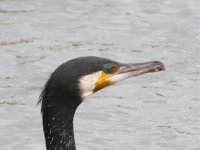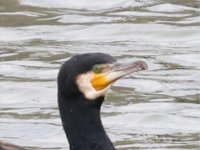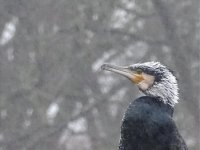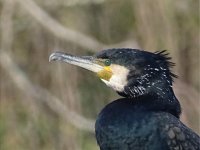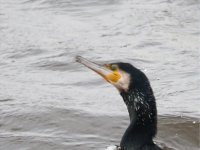Hi Gerben,
Since no-one more knowledgeable than me has replied, I will do my best.
Your bird is a Great Cormorant because of the shape of the yellow face patch.
1. As regards sub-species, Birds of the World (Cornell University, formerly Handbook of Birds of the World) thinks that sinensis and hanedae are the same. Mark Brazil - Birds of East Asia -
mentions both ssp but says the border between them is unclear. He then ignores the distinction and his description doesn't specify which ssp he is talking about (his book covers both Japan and China so the fact that he doesn't describe the difference is significant, I think, in that it suggests there isn't any significant difference).
If you accept that sinensis and hanedae are the same, then essentially the huge Eurasian landmass is one ssp, though the P. carbo carbo (mainly North American coastal) ssp may occur on the west of the continent.
In addition, I checked with five different Japanese-language books that I have, inlcluding two published in the last three years, and not one of them mentions any ssp at all. They simply say 'Great Cormorant'.
2. As regards the difference of Japanese (Temminck's) Cormorant and Great Cormorant, the most commonly used differentiating feature is the shape of the yellow patch behind the eye and down to the throat. If you start at the eye and follow the line of the yellow to the farthest point from the eye, it then turns vertically down or even convex in Great, whereas it is clearly concave in Japanese.
Below, I have attached an illustration from a Japanese book which shows this difference - Japanese at the top, Great at the bottom. (I hope this counts as 'fair use'.) (Incidentally, I think that the head-shapes might be the wrong way around, as I think that Japanese Cormorant has the more streamlined and slightly smaller head.)
However, in real life, it can be difficult to see this even in photos if the birds are distant. Some people seem to think that any bird at the coast must be Japanese, but I think this is quite wrong, and that Japanese will not usually be on the coast itself, but on rocks or small islands offshore.
There have been several threads on this topic in recent years; I have participated in three of them.
In this thread '
Closeup Temminck', Otarujef has a series of photos which clearly show the face pattern of Temminck's / Japanese, which you can see is different from your bird.
An earlier thread with less clear photos from Otarujef is '
HELP! difference'.
A longer thread which covered this topic in more detail, and in which I disagreed with others about the distribution of the two species, which got a little heated at one point, but ended in a friendly manner, but with no clear conclusion is '
Help with some ID from Japan'. I think Japanese Cormorant is rather less common than many suppose (at least where it can be seen clearly), and its distribution more restricted. However, although I have looked around, I haven't found much more in the way of solid information than is expressed by myself and others in the thread.
In the course of writing this, I looked at some photos of the mainly northwest US ssp P. carbo carbo which is apparently a marine bird (like Temminck's / Japanese). It seems to me that the shape of the yellow face patch of this ssp is intermediate between Great and Japanese. It made me wonder if maybe Japanese and P. carbo carbo might be more closely related than P. carbo carbo is to P. carbo sinensis? This would mean that the split between the two admitted species (Great and Japanese) has been wrongly placed. If anyone reading this knows about genetic or other studies which address this issue, I would be very interested to know.
Hope this helps.
MacNara




